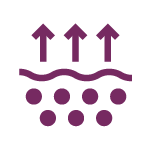Protecting & Restoring Long Island's Peconic Bays

This BMP includes seaweed and shellfish aquaculture, an emerging “green industry” that offers environmental and economic benefits to the region (Schott 2019; Bricker et al. 2018). Seaweeds and shellfish remove nitrogen and phosphorus from water and provide significant reduction of nitrogen levels in nutrient-enriched estuaries. Given this BMP does not address nitrogen reduction to groundwater, it is not directly comparable to the other BMPs included in this assessment.
New York State recently approved seaweed aquaculture in Peconic and Gardiners Bays, and is awaiting authorization by Suffolk County. Both seaweed and shellfish aquaculture require New York State Department of Environmental Conservation (NYSDEC) and U.S. Army Corps of Engineers permits and county or town lease agreements. Further, locations where bioextraction is needed most may not always coincide with shellfish-certified waters, reducing the full potential of bioextraction for human consumption.
A pilot study to establish baseline water quality and monitoring to determine effectiveness prior to implementation is required for seaweed aquaculture. Seaweed farming has the potential to raise ocean pH locally through carbon dioxide uptake and harvesting before the seaweed decomposes and releases it to the atmosphere (Duarte 2017). Cultivating seaweed and bivalves together can maximize the benefit to both organisms. A Peconic Estuary Seaweed Aquaculture Feasibility Study was conducted to identify the condition and locations best suited for kelp farming (Schott 2019). Current shellfish and aquaculture locations may be viewed at the Long Island Sound Study New York and Connecticut’s Shellfish and Seaweed Aquaculture Viewer and Long Island Nitrogen Action Plan (LINAP) is promoting shellfish and seaweed aquaculture through its Nutrient Bioextraction Initiative.
The following permit categories may be required for bioextraction, depending on location. Governor Hochul signed Senate Bill S65532A in December 2021, permitting kelp cultivation in Peconic and Gardiners Bays[1]. Suffolk County is currently conducting a pilot project, which would inform future permitting. New York State and Suffolk County have promoted shellfish aquaculture in the Peconic Bay to provide a sustainable fishery and achieve water quality goals. New York State ceded to Suffolk County title to approximately 100,000 acres of underwater land in Peconic and Gardiners Bays for the purpose of shellfish cultivation and authorized the County to prepare, adopt, and implement a shellfish aquaculture lease program for this region. Suffolk County developed an Aquaculture Program Management Plan in 2009 to guide the growth of the industry and recently completed a 10-year review of the program and is finalizing program updates, which include the following:
[1] https://www.nysenate.gov/legislation/bills/2021/s6532
Nitrogen removal rates of 10 pounds per year, or 125 and 160 pounds per acre per year have estimated for Gracillaria and kelp, respectively, for pilot studies in Long Island Sound (Yarish 2020). By comparison, nitrogen removal rates of oysters and shellfish have been estimated at 275 and 196 pounds per acre per year (Bricker et al. 2018; Hoagland et al. 2007).Nitrogen removal rates of 10 pounds per year, or 125 and 160 pounds per acre per year have estimated for Gracillaria and kelp, respectively, for pilot studies in Long Island Sound (Yarish 2020). By comparison, nitrogen removal rates of oysters and shellfish have been estimated at 275 and 196 pounds per acre per year (Bricker et al. 2018; Hoagland et al. 2007). Importantly, one aquaculture farm could cultivate all three of these organisms in a single year since the growing season of kelp (Dec – May) and Gracilaria (Jun – Nov) do not overlap and bivalves and seaweeds are often co-cultivated in integrated multi-trophic aquaculture (IMTA) schemes.
The economic value of seaweed aquaculture has been estimated at about $1,200 per acre (Van Patten 2015). The Suffolk County Department of Economic Development and Planning has estimated that the aquaculture lease program has the potential to generate approximately $1.5 million in market value (Suffolk County 2020). Thus, nutrient bioextraction not only has the potential to provide nitrogen reduction and associated benefits, it has the potential to provide a cost savings and a source of income for aquaculture farmers.
CDM Smith, 2020. Reclaim Our Water Subwatersheds Wastewater Plan. Prepared for Suffolk County Department of Health Services. February 2020.
Bricker, S.B., J.G. Ferreira, C. Zhu, J.M. Rose, E. Galimany, G. Wikfors, C. Saurel, R.L. Miller, J. Wands, P. Trowbridge, R. Grizzle, K. Wellman, R. Rheault, J. Steinberg, A. Jacob, E.D. Davenport, S. Ayvazian, M. Chintala, and M.A. Tedesco, 2018. “Role of Shellfish Aquaculture in the Reduction of Eutrophication in an Urban Estuary.” Environ. Sci. Technol. 52:173–183.
Duarte, C.M., 2017. “Reviews and Syntheses: Hidden forests, the Role of Vegetated Coastal Habitats in the Ocean Carbon Budget.” Biogeosciences 14:301–310.
Hoagland, P., H.L. Kite-Powell, and D. Jin, 2007. Business Planning Handbook for the Ocean Aquaculture of Blue Mussels. Marine Policy Center, Woods Hole Oceanographic Institution.
Schott, S., 2019. Peconic Estuary Seaweed Aquaculture Feasibility Study. Final Report to the Suffolk County Water Quality Protection and Restoration Program and Land Stewardship Initiative. April 2019.
Suffolk County, 2020. “Shellfish Industry.” Suffolk County Economic Development and Planning. Available at: https://suffolkcountyny.gov/Portals/0/formsdocs/ecodev/pdfs/Shelfish%20Flyer_022520.pdf
Van Patten, M.A., 2015. Seaweeds Clean Long Island Sound. Wrack Lines: A Connecticut Sea Grant Publication. Summer 2015.
Yarish, C., 2020. Presentation to the Long Island Sound Technical Advisory Group. December 4, 2020.
Sign up for News, Events and Information straight to your inbox.
